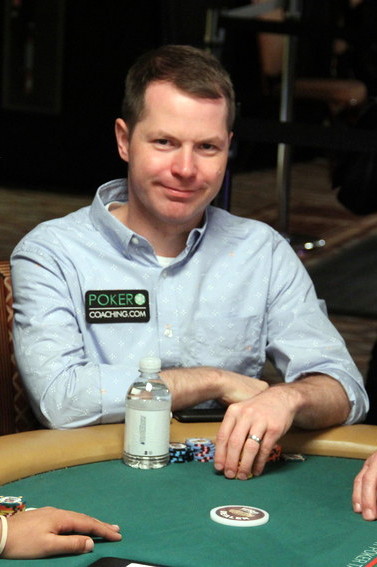






Your Bet Size Mattersby Jonathan Little | Published: Sep 20, 2023 |
|
|
 If you want to increase your poker skills and learn to crush the games, check out Jonathan Little’s elite training site at PokerCoaching.com/CardPlayer.
If you want to increase your poker skills and learn to crush the games, check out Jonathan Little’s elite training site at PokerCoaching.com/CardPlayer.
I was recently told about a hand from a $1,000 buy-in live poker tournament that illustrates an error many novice players regularly make.
With blinds at 1,000-2,000 with a 2,000 big blind ante, the action folded to our Hero in the lojack seat who raised to 5,000 out of his 75,000 stack with K K
K .
.
Hero’s preflop raise size to 5,000 is perfectly fine. The only time raising larger makes sense is when most of your opponents will refuse to fold any reasonable hand before the flop, which could potentially be the case in a $1,000 buy-in tournament. If they will call slightly larger amounts with the same range they will call 5,000 with, you might as well raise a bit larger to extract more value.
One such player who is incapable of folding any reasonable hand called in the hijack seat, as did the button, small blind, and big blind. The flop came K Q
Q 10
10 , giving Hero top set. That is lucky! The blinds checked and Hero bet 12,000 into the 27,000 pot.
, giving Hero top set. That is lucky! The blinds checked and Hero bet 12,000 into the 27,000 pot.
While betting is certainly ideal, Hero should probably bet larger, perhaps 17,000. Betting a bit larger sets up Hero’s stack up nicely to go all-in on the turn.
Also, this coordinated high-card flop is likely to connect well with at least one of the opponent’s hands. Almost no one will fold any pair with a decent kicker on this board to a 17,000 bet.
It is worth pointing out that checking with the hope of trapping someone is not a good idea because there are many turns that could easily give Hero the worst hand, and also, much of the opponents’ ranges will be medium strength hands, such as Q-J and A-10, that will call a bet, but will not bet if checked to.
Only the calling station hijack called. The turn was the 7 . Hero bet 25,000 into the 51,000 pot, leaving 33,000 remaining in his stack.
. Hero bet 25,000 into the 51,000 pot, leaving 33,000 remaining in his stack.
If Hero decided to go all-in on the turn, it would have been for an over-bet of 58,000 into the 50,000 pot. If Hero instead bet 17,000 on the flop, he would have 53,000 in his stack and the pot would be 60,000, allowing him to go all-in for less than the size of the pot. While this may not seem like too big of a deal, many players will happily call a bet for slightly less than the size of the pot but will fold to a bet of slightly more than the size of the pot.
As the stacks sit due to Hero’s flop bet size, a small turn bet is fine, but given Hero knows the opponent is not capable of folding any reasonable hand, an all-in may still be best even as an overbet. It is impossible to say without knowing the opponent’s specific tendencies, but if he is known to happily call off his entire stack with marginal made hands or pairs with draws, Hero should go all-in instead of betting 25,000.
The hijack called, and the river was the 2 . Hero went all-in for 33,000 into the 101,000 pot and the opponent thought for a while before folding.
. Hero went all-in for 33,000 into the 101,000 pot and the opponent thought for a while before folding.
Hero played the river well by going all-in. When you have the effective nuts as the aggressor with only a small amount of money remaining in your stack, going all-in is the only viable option. It is unfortunate that the opponent folded with what was probably a pair of tens with a draw, or perhaps just a jack for an open-ended straight draw.
Poker is an incredibly difficult game because seemingly inconsequential decisions early in a hand often turn into larger problems later. Also, you never know if any play is definitively right or wrong against your specific opponent. That said, I am quite confident that a larger flop bet would have made this hand work out better for Hero in the long run.
If you want more resources to help you improve your game, I put together a course called The 25 Biggest Leaks and How to Fix Them. This course is completely free inside the Card Player Poker School!
When you join the Card Player Poker School (it’s free to join), you’ll also get:
✔ Free downloadable preflop charts
✔ GTO preflop charts
✔ Video Classes
✔ Interactive Hand Quizzes
✔ Free Course: Master the Fundamentals
✔ Free Course: The 25 Biggest Leaks and How to Fix Them
✔ Free training every week
 Jonathan Little is a two-time WPT champion with more than $7 million in live tournament earnings, best-selling author of 15 educational poker books, and 2019 GPI Poker Personality of the Year. If you want to increase your poker skills and learn to crush the games, check out his training site at PokerCoaching.com/cardplayer.
Jonathan Little is a two-time WPT champion with more than $7 million in live tournament earnings, best-selling author of 15 educational poker books, and 2019 GPI Poker Personality of the Year. If you want to increase your poker skills and learn to crush the games, check out his training site at PokerCoaching.com/cardplayer.